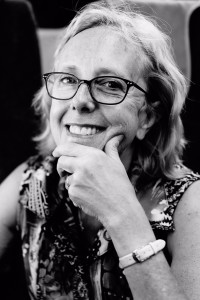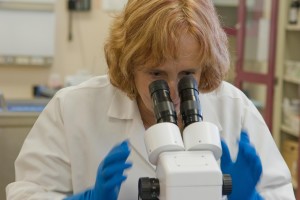 Mary Jumbelic is a retired forensic pathologist who served as chief medical examiner and clinical associate professor of pathology in Syracuse, New York. Her work has had an emphasis in injury prevention and mass disaster management, including identifying the dead following the tsunami in 2005 and at the World Trade Center in 2001. In her professional capacity, she has worked with hundreds of victims of violence and abuse.
Mary Jumbelic is a retired forensic pathologist who served as chief medical examiner and clinical associate professor of pathology in Syracuse, New York. Her work has had an emphasis in injury prevention and mass disaster management, including identifying the dead following the tsunami in 2005 and at the World Trade Center in 2001. In her professional capacity, she has worked with hundreds of victims of violence and abuse.
Born in Baltimore, Maryland, she is a graduate of UMBC and the University of Maryland School of Medicine, and has been featured in alumna profiles. In 2000, she received the Trailblazer in Forensic Medicine Award from the National Organization of Women. She chaired the child death review team in her county for over eleven years.
She has been writing since the age of thirteen and is currently working on her memoir that is a blend of stories from her personal and professional lives. Though extensively published in the arena of scientific literature, this is her first major venture in creative non-fiction.
Dr. Jumbelic’s nonfiction story, “The Boy” was awarded first place in our “On Courage” contest.
I write because: I must. There are words inside of me which have to come out. I have always felt compelled to pen my thoughts. A part of my career involved mass disaster work and I was known as the lady with the notebook, carrying my journal with me everywhere.
Something surprising I have learned about courage over the years is: that it is not always grand and obvious. Moments of quiet strength and the ability to do the right thing were apparent in many of the decedents I examined. People gave up their lives for anonymous strangers and family members stood up for those they loved. The forensic investigators I worked with on a daily basis had the most humble courage of all, facing next of kin at tragic scenes, and not losing their humanity.
I feel most courageous when I am: representing those who can no longer speak for themselves. They make me fearless.
Some Things You Might Find Interesting About Me
About “The Boy”
“The Boy” is the graphic scene of a double murder and the haunting vision it creates for the forensic pathologist called to examine it. The duty she performs contrasts with her personal angst. Only at home with her own family, do the ghosts of the day fade as the sweet embraces of her children begin to heal the pain.

“The Boy”
I stare at the artwork of bright yellow, red, and blue that my children created with finger paint. This picture of their hands hangs on the wall of my office. It is an image of playfulness and youth. Meditatively rocking in my leather swivel chair, I savor the steam from a freshly brewed cup of chamomile tea, Peter Rabbit’s favorite. This reminds me of tea parties, cinnamon toast, and dozens of love-worn stuffed animals around the kitchen table with my three boys. The snow falls thickly and it is pitch black outside though barely 5:00 PM. Yet there is a lot of work to do before calling it a day. Feeling pensive, I continue to gaze at the painting.
The simple, colorful images transform into another scene. My pulse quickens and my breath speeds up with the remembering. It is no longer snowing; the weather is warm, stifling even, in my blue uniform jumpsuit. In front of me, is a small two bedroom ranch house, cream shingles with brown trim. The walkway is lined with yellow tape that reads “Crime Scene, Do Not Enter.” Police dutifully turn and nod at me as I pass. The setting is muted although there are at least ten people about. Everyone senses the tragedy that permeates the air and maintains a respectful silence.
Entering the house, I briskly walk up the few stairs to a child’s bedroom. The only sound is the swooshing of the plastic booties on my feet.
“Morning, ma’am,” a detective says in a hushed tone as he pushes open the door. It is an odd moment, and I imagine myself to be a dancehall girl entering an old western saloon. This distracting image vanishes quickly.
There are tiny, bloody handprints forming a crooked line from the floor to the wall to the door. Some are right sided, some left, with many having distinct details, strong enough to make a fingerprint identification. A few of the twenty or so marks are less defined and smeared. The individual imprints are unevenly spaced yet determinedly making a path towards the bedroom exit.
The detective enters the room and closes the door for me to take a look at the other side, where there is more staining on its lower half. The brass knob is discolored crimson as slippery, attempts were made to turn it.
My throat catches and I blow deeply out of my nose in a forceful exhale.
“Need anything, Doc?” the detective asks quietly.
“No,” I say, “but tell the investigator, we’ll be ready for photos in a minute, thanks.” As the county medical examiner, this case is under my jurisdiction.
In the middle of the wooden floor, between the twin bed and the door, lies a small blond child. He’s three years old with a thin build and a Dutch-boy haircut making him a doppelgänger of my middle son at that age. The little boy is on his stomach, arms outstretched, as if he got tired while playing with the toys scattered all about him. There are action figures, wood puzzles, and foam building blocks. Except for the sanguineous liquid pooling around his head, the toddler could be napping. His skin is pale, white but his palms and Superman pajamas are bloody.
My gloved hands carefully turn his body over to examine the source of the bleeding, which are large wounds on his neck. Holding his head with my left hand, and a ruler in my right, I measure the length of the cuts. A serrated knife has been drawn against his neck with such tension it has created little hatch marks from its edge along the adjacent skin. There are four long incisions that start near the ear and continue to the Adam’s apple. One is deep and has sliced into the jugular vein.
Pausing to make notes about the size and shape of the injuries, I explain to the detective what kind of weapon the assailant used, showing him the unique pattern. He excuses himself to inform the CSI about this new information.
I try to imagine the last moments of this boy’s life. He would be confused about the sudden pain, touching his neck with his hands. Inspecting his fingers reveals there is a small slice at the tip of the right index where he must have tried to push the blade away.
Gently lifting the pajama shirt to get a closer look at his chest and arms, I see bruises on the tops of the shoulders and biceps where he was forcibly held down. The distinguishing circles made by adult man-sized digits are visible. They will become more distinct with time, aiding the investigation. Brushing the hair away from his forehead, a red swelling is conspicuous. It could be from a direct hit to his face or the fall at the time of fatal collapse.
His airway is uninjured so he was probably able to scream. The abstract audio echoes in my mind. I envision the boy’s terror as he bled slowly from the nick in his jugular vein. Probing gingerly, I observe that the carotid artery is spared. If it had been pierced, the resulting blood loss would have caused unconsciousness in seconds. Instead, the slowly bleeding vessel provided the red ink for the trail of handprints.
If he had intended to escape to find his mom, it was futile anyway. She lies dead in the adjoining hallway, her head crushed by a nearby ornamental rock. This stone is the weapon that was wielded by the same murderer. Splayed on the floor, face down with arms outstretched toward her son’s bedroom door, she appears, even in death, to exhibit a mother’s instinct to save her child.
Blood soaks her long, brown hair and covers the wounds in the skull just below. Large clots form a halo around her head indicating that she has been dead longer than her son. I mentally arrange the timeline. The boy most likely heard the fighting between his mom and the killer. Yet she might not have known his torment. How many blows did it take to silence her? Did he gag her? Did she claw at him? These questions will have to wait until the bodies are transported to the morgue where surgical lights and dissecting tools can help to answer them.
Parent and child are separated physically by the bedroom door but connected more tangibly by their frantic journey to reach one another.
“Hey, Doc,” the detective says as he returns, “we found him. Caught him on surveillance tape. He bought a pack of smokes at the convenience store, a mile from here. Just a matter of time, now.”
I reflect on the police dragnet underway, that began even before the murders. The cops will get their man; they knew all along who the killer is. Neighbors phoned 911 when they heard a loud argument and screaming. The person responsible for this gruesome affair is the estranged husband of the murdered woman, the biologic father of the murdered boy. Another tragic ending to a failed order of protection.
Later that same night, somber and withdrawn, I enter my house to shouts of “Mommy’s home!” Feet thunder toward me and arms find purchase around my knees, waist, and neck, as my three young sons welcome me back to my world. Tears flow freely now, unrestrained by the confines of professionalism. They spill onto my boys’ hair and faces, embraces returned. Living childhood surrounds me with youthful bodies undamaged by physical rage and brutality. We share the joy of endless hugs and kisses.
There is a knock on my office door interrupting this journey into the past.
My secretary is saying, “Dr. J, we’re leaving now. Don’t forget to lock up.”
“Sure thing,” I call out, though the words stick slightly. My throat is dry and I reach for my cup of lukewarm tea to quench the thirst rising within me. To leave with my co-workers would be a welcomed relief. Yet a few more papers need to be signed to take care of the business side of death.
The handprints in the picture are now primary colors again. My pulse and breathing have returned to normal. I concentrate on the finishing paragraphs of the reports of the day.
Tonight I will return to the beauty and simplicity of my home, my sons, my husband, and my mom, comforted by intimacy and love. The panic and sadness of the slain family, has faded into the background, but is not forgotten. My children’s painting forms a window into death’s pain, reminding me to retain those instances of horror. These memories honor the young boy and his mother. I speak for the dead and it is my job to bear witness and to remember.

A Conversation With Dr. Mary Jumbelic
It is such an honor to share Dr. Mary Jumbelic’s powerful nonfiction story, “The Boy,” with our audience and to award her evocative piece of work first place in our “On Courage” contest. Those of us who read “The Boy” were deeply affected by it. The detail in Mary’s writing is palpable and paints a piercing picture of the senseless horror and crime of domestic violence homicide.
For the judges, “The Boy” spoke to our theme of “courage” on several levels. Firstly, before reading Mary’s submission, I don’t think any of us had ever stopped to consider the courage it takes to show up for work every day as a forensic pathologist or investigator. Nor had we considered how difficult it must be to put aside emotion in pursuit of the truth, and then to have to share that truth—no matter how devastating—with the victims’ often heartbroken next of kin. We thought of how agonizing it must have been for Mary and her colleagues to relay information on the horrendous deaths of this woman and child to the decedents’ family. It broke our hearts. Mary’s story left all of us with a new and profound respect for those working in her profession.
Secondly, we learned of a mother’s courage. Mary’s description of the murdered woman, lying with arms outstretched toward her child—both victims of domestic violence—in one final and desperate gesture of love and the instinct to protect, had several of our judges in tears. Sadly, this woman represents many women, so many who have been murdered by partners or ex-partners. And the child, this child also represents the many children who are the murdered victims of domestic violence. But it doesn’t have to be this way. For those who work in the areas of domestic violence education, prevention, and advocacy, this is another all-too-common reminder of just how important their work is and of the continuing need for relentless progress and hope.
Lastly, we were struck by Mary’s courage, which I think we all felt speaks to the power of love. To experience the ugliness and brutality that Mary has in her work as a forensic pathologist and medical examiner, and yet to choose, still, to love—to love her children, her husband, her mother, to love life—takes immense courage. We are inspired by that and by her.
It was a privilege to interview Mary and to learn more about the woman behind the story. We hope you enjoy.
— Chloé
CM: Congratulations, Mary! We were deeply affected by your powerful submission. Thank you for writing “The Boy” and for submitting it to our contest for consideration. Please tell us, how did you hear about the “On Courage” contest?
MJ: I wrote this piece for a writing class and fellow students were equally interested and appalled by it. These reactions were familiar to me as I had experienced them when talking about my work in other venues. Yet I felt it was a strong description and that the boy and his mother needed a voice. When I saw your contest, I knew their story had found a home.
CM:When did you first start writing? What do you find yourself writing about?
MJ: I first began writing when I received a diary as a Christmas present from my parents in 1969. At the age of 13, this opened up a new world to me in which I could pour my grandest desires and most intimate thoughts. Through the years, I have continued to keep journals, write poetry, short stories, and novels, as well as publish scientific articles.
CM: What goals do you have with your writing?
MJ: My current writing goal is to complete a personal memoir that I began two years ago.
CM: Who are some authors you admire and enjoy reading?
MJ: I enjoy a wide variety of literature, mostly fiction. Stephen King and J. K. Rowling are two authors whom I respect a great deal. They managed to make their respective genres spellbinding for me when I had only slight interest in either horror or fantasy, weaving characters and settings with words and thrilling me in the process. Growing up I enjoyed the classic detective stories of Agatha Christie and Sir Arthur Conan Doyle, and still read a lot of modern writers of this category including Patricia Cornwell, Kathy Reichs, and Ira Levin. Currently on my nightstand are “The Art of Memoir” by Mary Karr, “Don Quixote” by Cervantes, “The Divine Comedy” by Dante, “Justice” by Dominick Dunne, and “The Nature of the Beast” by Louise Penny.
CM: “The Boy” is graphic and disturbing. A story about such a tragedy should disturb us, shouldn’t it? Do you think that we have become too comfortable with hearing these kinds of stories?
MJ: The media is rife with graphic images of blood and violence and perhaps some viewers are complacent with death and injury. However, “The Boy,” emphasizes that on a personal level, pain and loss does and should disturb us.
CM: It must have taken great courage, every day, to do your job as a medical examiner. We were struck by your courage and by the senseless horrors that you were sometimes forced to confront so closely in your work. What first drew you to your profession? What kept you going back, day after day?
MJ: Following the death of my father which occurred when I was 13, I made the commitment to become a doctor. Then at the age of 15, while a sophomore in high school, I had the opportunity to visit the Medical Examiner’s Office. It was a profound experience for me seeing a human body and learning about death from an autopsy. Both of these events influenced my decision to become a forensic pathologist so that I could use medical science to explain to those left behind how their loved one had died. It was this search for the truth and the effort to answer the survivor’s questions that kept me going back day after day.
CM: Was the experience you wrote about in “The Boy” something you encountered more than once? How would you say that this experience and other ones like it impacted your views or understanding of domestic violence? Had you given any thought to domestic violence before getting involved with your career?
MJ: Prior to my job as a Medical Examiner, I was personally untouched by domestic violence. Unfortunately in my profession, I saw the horror of it too often. The story in “The Boy” was not a rare occurrence, though most victims came into my office alone. There are so many ghosts in my mind from the fatalities of mothers, wives, girlfriends, partners, children, and many more stories still to be told.
CM: Do you remember that day specifically and what emotions and thoughts you were experiencing?
MJ: The day of the deaths of the young boy and his mother was a day much like others, full of professional responsibility and personal compartmentalization. The sadness and the intense pain came later and never really went away.
CM: For us, the theme of courage was also revealed in the heartbreaking line you wrote about the “resting” position of the mother who had been murdered by her spouse. It was a powerful and touching observation on your part, and one that has clearly stuck with you. As a woman and as a mother, what do you make of that line, of that gesture?
MJ: The position of the mother was important for me to portray clearly. Even in death, she reached out to her child, to offer comfort, protection, and guidance. As a mother myself, I felt the power of that last movement, a final gesture of love to her son.
CM: You said in your piece that you “speak for the dead,” and it seemed that you believe you have a certain responsibility to be a witness, to speak certain truths that they are no longer able to speak. Can you talk about that?
MJ: I have always considered the dead as my patients and feel I am their last voice. They speak to me through their wounds and disease, telling me about their pain and suffering. I am witness to their injuries, and their final moments. No detail is too small to notice — recently shampooed hair, manicured fingernails, a scar from falling off a bike as a kid. Each makes the person unique and I care very much about the individual lying on my autopsy table. In the end, I summarize all of this into a written report which represents the concluding conversation we’ve had.
CM: What do you hope that people will take away from “The Boy”?
MJ: If the reader can feel for a brief moment the horror of the murders and also the sublime joy of life, then “The Boy” is more than just a personal memory.
CM: What do you think you have learned about courage over the years?
Courage is very difficult to define in the moment. It is best seen through a lens of time and experience. I feel its power most intently when I am standing up for someone else and not myself. It is hard to be strong in the face of abuse and power but tenacity and moral conviction are formidable allies to courage. Helping someone else can provide us with the strength we need to help ourselves.
CM: What are you working on now in terms of your writing? Are there any other projects you’d like others to know about?
MJ: I am currently working on my memoir containing a personal transition in my life combined with my experiences as a physician.
CM: Where can people connect with you or learn more about your work?
MJ: Sharing with people in a writing format is relatively new to me. I am somewhat well known in the world of forensic pathology, having written extensively in the field and worked in national and international capacities. One of my first scientific articles appeared in 1990 in the Journal of the American Medical Association on the topic of toddlers accidentally drowning in buckets. Because of this study, the 5 gallon bucket manufacturers agreed to put warning labels on their products, which are still prominent today. More recently, I have appeared on the television shows Dateline and 48 hours concerning the death of Leslie Neulander, whose husband was responsible for and almost got away with murder.
CM: Are there any final thoughts that you’d like to add?
MJ: I am grateful for this opportunity to share my work in a supportive environment and honored by receiving first place recognition.
Mary was a top ten finalist in the 2015 AARP & Huff/Post 50 Memoir Contest. She appeared on the television show 48 hours concerning the death of Leslie Neulander. Mary is also featured in the books Hard Evidence: Case Studies in Forensic Anthropology and Final Acts: Death, Dying, and The Choices We Make. To learn more about Mary, please click here.
Photography by Marc Safran, courtesy of Marc Safran Photography.
